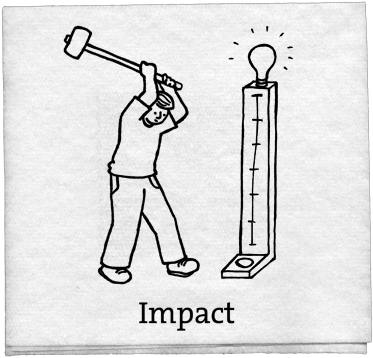Entries from June 2009 ↓
June 29th, 2009 — copywriting, copywriting services, freelance copywriting

Guess what? There are millions of adverts out there on websites, in newsletters, brochures, emails, TV, magazines…
So, what have you got to do to make yours stand out?
Look at what your competitors are doing…
…and then do something different.
If you study the advertising in your industry, you will probably be able to identify a common theme running through most of the ads. They may say similar things, have a similar layout or follow a similar format.
To make yours stand out you need to stand apart from everyone else.
Great. But how exactly am I supposed to do that?
Quite often you will find that because you know your industry so well, you become blinkered. Without realising it you would have fallen into the trap of churning out the same copy.
Often, when companies realise this is what’s happening, I get a call. As a freelance copywriter coming in from ‘outside’ I can look at their company with a fresh perspective. Whether I’ve worked within their particular field before or not, is neither here nor there. The fact is that I can look at the product or service with an unbiased view and produce something fresh, interesting and attention-grabbing.
Stand out and be noticed
I suppose you want a few hints now on how to make your ads more interesting. Here goes…
- Add a personal touch by using a hand written letter on your ad rather than text.
- Add a list of respected people who’ve bought from you – but make sure you get their permission first.
- Use before and after pictures to illustrate the benefits of your product.
- If you’ve had an article or review written about your company, use it in your copy – it gives respectability and credibility to your advert.
- If you offer free bonuses always add their monetary value so your readers can see what a great deal they are getting.
- If possible use a famous person to promote your product/service.
- Add your picture and contact details to your advert.
- Tell your readers that you will donate a percentage of their purchase price to a specific charity.
- Ask ‘yes’ and ‘no’ questions in your copy to remind them of their problem and to make them think about what will happen if they don’t buy your product.
- Create a competition – for example enter them in a free prize draw if they can find the 3 miss spelt words or the 5 flowers in your ad. The longer you can keep them reading the greater chance of getting them to buy.
Simply by using one or two of these suggestions in your copy, your company will be seen as standing apart from the rest. Being different is good. Being different is being seen.
June 26th, 2009 — copywriting, freelance copywriting
I am a huge fan of Copyblogger and loved this post that I came across the other day.
We’ve all experienced this at some time. Your copy is fantastic, it’s persuasive and powerful and yet yoru readers are stumbling when it comes to getting out their wallets.
Why?
Well I’ll let Sonia Simone (Senior Editor of Copyblogger) explain in her excellent post The #1 Conversion Killer in Your Copy (And How to Beat It) | Copyblogger.
What makes people almost buy? What makes them get most of the way there, then drop out of your shopping cart at the last second? What makes them stare at your landing page, wanting what you have to offer, and yet, ultimately, close the page and move on to something else?
It turns out there’s a hideous troll hiding under the bridge. Every time you get close to making a sale, the troll springs out and scares your prospect away. Get rid of the troll and your copy will start converting better than it ever has before.
The ugly, smelly, dirty, bad-mannered troll is prospect fear. And it’s sitting there right now, stinking up your landing page and scaring good customers away.
Fear of wasting money
Remember when you were a kid and you went to that rinky-dink carnival that came through town? After eating all the cotton candy you could manage, and throwing it all back up again on the Tilt-a-Whirl, you checked out something called the Midway.
Remember that persuasive fellow who convinced you to spend a whole months’ allowance throwing softballs at those damned milk cans?
It looked so easy. He showed you exactly how to do it. Toss the softball, knock over the milk can, win a cool stuffed animal for a prize. Simple.
You spent quarter after quarter trying to do it yourself.
When all your quarters were gone, you got an inkling. It looked easy, but actually if you were standing at the throw line, it was pretty close to impossible. Now the carnival guy had all your money, and you didn’t even have an ugly green plush monkey to show for it.
The troll is born.
Fear of mockery
When the sting of the carnival wore off, you were innocently minding your own business and you ran across an ad for the wonderful product Sea-Monkeys.
They were little people! With tails! They looked pretty awesome on the cover of the package. You begged your parents to get them for you and told everybody you knew. Your little brother. Your best friend. Your entire third-grade class.
This was going to be so cool. The ad said you could even teach them to do tricks. You planned on getting them medicine, vitamins, special formulas, everything they needed to be the happiest pets ever.
You followed the instructions to the letter. You waited breathlessly. You told anyone and everyone how amazing this was going to be.
It turns out Sea-Monkeys are just brine shrimp. In no way do they resemble little people. They resemble fish food, which is what they are.
Your little brother, your best friend, and your entire third-grade class now thought you were an idiot. And they delighted in letting you know that at every opportunity.
The troll gets a little bigger.
Fear of feeling stupid
Every time we’re betrayed by a sleazy salesperson, we toughen up just a little. The troll grows. Our mistrust grows and our inclination to believe shrinks.
And then a blogger shows up with a wonderful ebook, MP3 course or membership site that will solve a problem that’s been really bothering us. Let’s call that blogger . . . you.
We want to believe you. We want to get the benefit from what you have to offer. We want to have something — anything — work out the way it was promised.
We would love to be able to trust our own judgment.
But the troll keeps whispering in our ear, with his truly horrendous breath, how stupid we’re going to feel when we fall for that again.
(By the way, do you think the troll gets even stronger when the economy is bad and folks are in a general state of anxiety? Yep, I agree.)
How to kill the troll
Killing the troll isn’t easy, but you have to do it if you want to monetize your site.
Trustworthiness, transparency, credible authority, lots of high-value content, and just plain old decency are your best weapons.
Everything on your site needs to show that you can be trusted. Real contact information. Showing your photograph. Displaying seals for anti-hacker technology and the Better Business Bureau on your shopping cart. FAQs that actually answer questions. Clear, reassuring calls to action.
Every detail matters. Even things like hosting your site on your own domain, or how frequently you post. Everything you do needs to build trust and kill the troll.
Unless you sell to ten-year-olds, your prospect has been kicked around so often by unscrupulous (or incompetent) businesses that the troll is a very hard fellow to kill. Give the prospect any tiny reason to mistrust you, and all those wretched old experiences come back.
There’s an old joke that a second marriage is the triumph of optimism over experience. In fact, that’s exactly what happens every time you make a sale, especially to someone who hasn’t done business with you before.
So let’s declare war on the trolls. Be extraordinarily trustworthy. Show your value. Put your customers first. Keep your promises.
The troll is tough and hard to kill. But with dedication and commitment, we can chase him off to go wreck somebody else’s business.
June 24th, 2009 — copywriting, copywriting services, freelance copywriting

It doesn’t matter what industry you are in, you need great copy if you are going to have an impact on your market.
Whether all your marketing is offline, online, or a combination of both, your sales writing must be active, interesting, persuasive, creative and compelling if it is going to attract potential customers.
As a freelance copywriter I am approached by numerous companies from all industries looking for great sales copy. The majority of these appreciate the skill that is required to craft copy that will attract, promote and sell their products. They understand the power of professionally written copy and therefore see it as an investment.
They don’t look at my quote as an expense – they see it in terms of what the copy will produce. By investing in my services they will achieve x% higher sales and greater market visibility.
If you needed dental work, you wouldn’t get a quote, scoff at the cost and then decide to do the extraction yourself with a pair of plyers. You would know that you need a professional to ensure the best results possible.
Admittedly that example is a bit extreme, but I think it illustrates my point.
Your marketing materials are your company – they are what your potential customers will judge you on. If your brochures, website copy, newsletters, emails and reports are wishy washy, bland, boring and badly written your company will come across as that too. Utilise the services of a professional copywriter, and you will be seen as dynamic, customer centred and professional.
June 22nd, 2009 — copywriting, copywriting services, copywriting tips, freelance copywriting
A copywriter knows that to get their readers to do what they want they have to get inside their heads and understand what makes them tick.
Psychology is therefore a big part of the copywriting process.
Understanding how your reader feels, what they are looking for in life and what problems they are looking for solutions to is the real key to effective copywriting.
It sounds rather daunting, but it is something that can be easily achieved.
Put yourself in the shoes of your reader – why would they want the product you are selling? What will they get out of it? What problem could they have that would be solved by it?
OK, that may seem too much like guess work for many, so how about doing a bit of research. I am sure you know people from all walks of life, many of whom could be prospective buyers. Talk to them; ask them their opinion on the product. Tell them about it and see how they react. Ask them:
- What would make them buy?
- Why they would buy?
- What they would hope to achieve from buying it?
Armed with your newfound insight in to why they would buy, you now need to incorporate into your copy some psychological triggers that will encourage them to get out their credit cards:
- People love surprises – tell them they’ll get a surprise free bonus when ordering.
- People want an easier life – make ordering easy and give easy product instructions.
- People like security – tell them you provide a secure ordering process and privacy policy.
- People like compliments – praise them for considering your product.
- People are curious about how it will affect their lifestyle – use ‘Secret’ and ‘Confidential’ to pick their curiosity.
- People like to invest in their future – use the words ‘invest in your product’ rather than ‘buy’.
- People like to have the newest or latest things – use words like ‘new’, ‘just released’.
- People want their problems solved – tell them what problems they have and how your product will solve them.
For many people buying is an emotional action rather than a rational one. By utilising these psychological triggers you can persuade them to buy your product.
The result? Happy customers and a happy copywriting client.
Sally Ormond is a professional freelance copywriter. She has worked with numerous companies spanning a wide range of industries. Her comprehensive range of copywriting services helps her clients save time and money while increasing sales and their market visibility.
June 18th, 2009 — copywriting, freelance copywriting
 You may recall a post on this blog a little while ago called “Proofreading – 3 Simple Steps to Perfection” in which I mentioned a letter I’d received from Google. It was offering £50 of free advertising with Google AdWords but they’d made a blunder:
You may recall a post on this blog a little while ago called “Proofreading – 3 Simple Steps to Perfection” in which I mentioned a letter I’d received from Google. It was offering £50 of free advertising with Google AdWords but they’d made a blunder:
1. You control where you ad is showing – by country, region or town
Argh! How could a company like Google make such a mistake?
Well, this morning I received another letter from them with the same offer. Guess what?
I opened the envelope with baited breath…had they heeded my words?…Had the letter been properly proofread this time?…
The answer is…YES!
The entire letter is blunder free. Well done Google!!!!!



 You may recall a post on this blog a little while ago called
You may recall a post on this blog a little while ago called 




